November 2, 2007
Air Date: November 2, 2007
FULL SHOW
SEGMENTS
Climate on the Campaign Trail
/ Jeff YoungView the page for this story
What would the Democratic presidential candidates do about global warming? Living on Earth's Jeff Young finds out most have aggressive plans on climate change, but they're squabbling over which would have the will to really do something. (05:30)
The Lethal Legacy of Lead
View the page for this story
A recent study finds removing lead from gasoline and paint 20 years ago could be linked to a drop in national crime rates. But, the story isn't that simple. Host Bruce Gellerman talks with Kim Dietrich, professor of environmental health at the University of Cincinnati College of Medicine, to find out what other factors make certain individuals more likely to commit crimes, and how lead’s involved. (06:30)
Primates in Peril
View the page for this story
One in four species of non-human primates are in danger of going extinct, according to a new report released by Conservation International and the World Conservation Union. Host Bruce Gellerman hears the sounds of the Sumatran Orangutan and talks with Russ Mittermeier, president of Conservation International, and chairman of the report. (06:00)
Is Chicken Little Right?
View the page for this story
If you ask Paul Ehrlich, a professor of population studies at Stanford University, he’ll tell you the new UN report on the state of the global environment is old news. Dr. Ehrlich talks with host Bruce Gellerman about overpopulation, famine, and climate change, and the urgent need for the human species to save itself from disasters of its own making. (08:45)
Channeling Thoreau
/ Tom Montgomery-FateView the page for this story
Writer Tom Montgomery-Fate ponders falling maple seeds and Henry David Thoreau’s words. (02:45)
Diet for a Dying Planet
View the page for this story
Environmental activist and physicist Vandana Shiva talks global food politics with Living on Earth's Steve Curwood. Shiva is editor of the new book, "Manifestos on the Future of Food and Seed," which advocates local, organic and diverse food production. (12:30)
High Infatuation
/ Ashley AhearnView the page for this story
Professional rock climber Steph Davis is passionate about rocks. She’s traveled the world in search of her next ascent, scaling mountain peaks from Patagonia to Pakistan. Living on Earth’s Ashley Ahearn produced an audio profile of Steph Davis. (03:30)
This week's EarthEar selection
listen /
download
Cacophony on the streets of New Delhi.
Show Credits and Funders
Show Transcript
HOST: Bruce Gellerman
GUESTS: Steph Davis, Kim Dietrich, Paul Ehrlich, Russell Mittermeier, Vandana Shiva,
REPORTERS: Jeff Young
COMMENTATOR: Tom Montgomery-Fate
[THEME]
GELLERMAN: From Public radio International. This is Living on Earth.
[THEME]
GELLERMAN: I’m Bruce Gellerman. For four decades he’s been sounding the alarm. Now Paul Ehrlich, author of “The Population Bomb,” says ‘I told you so.’
EHRLICH: I warned 40 years ago about climate change, what do we have going on now? I warned 40 years ago about emergent diseases, what do we have now? I warned 40 years ago that if we didn't do something about the population situation, people would still be hungry. Well we've got many, many millions of people hungry. So, Chicken Little says the sky is falling, just remember, maybe chicken little is right.
GELLERMAN: Also, rock climbing is tough love.
DAVIS: You’re sleeping on the wall, or in the snow cave. And your whole life is a very different thing. It’s much more simple and everything means a lot more.
GELLERMAN: High infatuation and more, this week on Living on Earth. Stick around!
[THEME]
ANNOUNCER: Support for Living on Earth comes from the National Science Foundation and Stonyfield Farm.
Climate on the Campaign Trail

Democrats debate who's best suited to tackle global warming as they try to stand out in the crowd on climate change. ((c) Drexel University)
[THEME]
CURWOOD: From Public Radio International in Somerville, Massachusetts, this is Living on Earth. I’m Bruce Gellerman, sitting in for Steve Curwood. Global warming is one of the defining environmental issues of our time, but only now has it become high profile among presidential hopefuls. Today, we take a look at where the Democratic candidates stand on climate change.
Living on Earth’s Jeff Young reports the debate is not so much over climate change policies, but who has the political will to really do something if elected.
[MAN SAYS INTO MICROPHONE ‘STARTING WITH SENATOR DODD’ APPLAUSE]
YOUNG: When Democrats stood on a Philadelphia stage for their most recent debate, Connecticut Senator Chris Dodd tried to stand out on the issue of global warming. Dodd says his call for a tax on carbon emissions has support from some unexpected places, but not his fellow Democrats.
DODD: I find it somewhat startling here that Ronald Reagan’s former secretary of state and George Bush’s first economic advisor are frankly more courageous and bold on energy policy than my fellow competitors for this job. So the corporate carbon tax, taxing carbon, is a critical element if you’re going to achieve this kind of energy change we need in our country.
YOUNG: Dodd’s plan would tax sources of greenhouse gases like oil companies, manufacturing and power plants and spend that money on cleaner energy sources, like wind and solar. But a tax is a tough thing to sell, and Dodd’s campaign is floundering.
All other Democratic candidates favor a cap and trade approach to cut greenhouse gases. Most of them aim for an 80% reduction in CO2 emissions by mid-century—about what climate scientists say is likely needed to avoid the risk of the most harmful warming.
Those proposals win kudos from conservation groups but that leaves a political problem—when their climate platforms are so similar how can candidates stand out in the crowd? New Mexico Governor Bill Richardson, who once led the nation’s department of energy, says it takes leadership experience.

Democrats debate who's best suited to tackle global warming as they try to stand out in the crowd on climate change. ((c) Drexel University)
YOUNG: The global warming debate among Democrats has shifted from a comparison of plans to a contest of wills: which of them would really get it done? Illinois Senator Barack Obama says it means standing up to powerful economic interests.
OBAMA: We've got major global challenges like climate change. And that's going to require big, meaningful change. It does not mean, I think, changing positions whenever it’s politically convenient. When I go to Detroit and I say to the automakers that they need to raise fuel efficiency standards, not in front of some environmental group, that’s the kind of consistency and principled leadership I think is what’s going to move us in the next direction. That’s what I’d provide as president.
YOUNG: The implication, of course, is that other candidates lack such principle. Obama didn’t name names, but former North Carolina Senator John Edwards did.
EDWARDS I think that if people want the status quo; Senator Clinton is your candidate. The reason we haven’t tackled global warming is because of oil companies, power companies, and their lobbyists. And the question is, what are we going to do for our children? Are you wiling to look your children in the eye tonight and say I’m going to turn this mess over to you.
YOUNG: New York Senator Hillary Clinton, the frontrunner, was ready for attacks from her Democratic rivals. She responded with a pledge to take on Republicans, who she says obstruct efforts to deal with global warming.
CLINTON: On every issue, from health care for children to an energy policy that puts us on the right track to deal with climate change and to make us more secure, I have been standing against the Republicans George Bush and Dick Cheney and I will continue to do so and I think Democrats know that.
[SOUNDS OF LOTS OF PEOPLE TALKING]
YOUNG: The spat continued in the spin room after the debate. Joe Trippi, with the Edwards campaign, painted Clinton as too tied to Washington special interests.
TRIPPI: If you’re not going to take on the oil industry and stop taking the money from their lobbyists, how the hell are you going to do anything about global warming?
YOUNG: Campaign finance records show Clinton has taken about a million dollars from energy and natural resources interests in her senate and presidential campaigns—that’s more than her Democratic rivals. But Clinton strategist Mark Penn echoes his candidate’s words—that it’s the record that really matters.
PENN: Well, she has a 35-year record of fighting for issues, which neither Obama nor Edwards have. You know, change is—as she said—change is just a word unless you have the strength and experience to make it happen.
YOUNG: The Democrats will hear much more about climate change from voters. One example: South Carolina has an important early primary contest. And 100 South Carolina mayors just sent candidates a letter urging them to make global warming a top priority when they campaign in their towns. For Living on Earth, I’m Jeff Young in Philadelphia.
GELLERMAN: We’ll take a look at where Republican candidates stand on climate change in an upcoming show. In the meantime, learn more about global warming politics on our website loe.org.
Related links:
- The League of Conservation Voters is tracking candidates on climate change
- Read the transcript of the Democratic debate in Philadelphia
- Living on Earth's Report: The Hottest Global Warming Bill in Congress
- Living on Earth's Report: Global Warming Guides Voter Concern
- Living on Earth's Report: Giuliani Candidate Profile
The Lethal Legacy of Lead
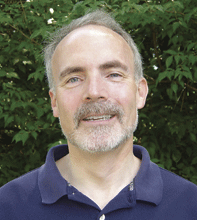
Kim Dietrich (Courtesy of University of Cincinnati)
GELLERMAN: Lead is an insidious substance. The human body has no use for the metal. But once inside, it can damage the brain, leading to learning disabilities, impulsive behavior and violence. Now, it seems exposure to lead as a youth can also be linked to crime later in life. A recent study correlated the phase-out of lead in paint and gasoline in the 1970s with crime rates two decades later and found in the words of the researcher Rick Nevins, ‘a stunning fit.’ As the amount of lead in the environment declined, so did the crime rates in nine countries. In fact, Nevins says, the phase out of lead did more to stop violent crime among people who came of age in its demise than any social policy. Kim Dietrich at the University of Cincinnati College of Medicine has also be studying the pernicious effects of lead.
For the past 30 years he’s been following inner-city kids from the time before they were even born until now. Professor Dietrich says the latest findings linking crime and lead are no surprise, but he's got even better evidence.
DIETRICH: Well, even though these ecological studies were generally well done, they’re limited, because they cannot correlate individual lead dose with individual behavior. So, you’re not going to see a one-to-one relationship between lead exposure and engaging in anti-social behavior but the trends are clearly there and the relationships in our particular study in Cincinnati were quite robust.
GELLERMAN: And what did you find?
DIETRICH: What we found was a robust relationship between both exposure to lead in the womb, and during early childhood. And the rate of criminal arrests in these individuals when they were in their early twenties. And this association was strongest for crimes involving violence.
GELLERMAN: So can these numbers help explain the disproportionate numbers of minorities who are incarcerated?

Kim Dietrich (Courtesy of University of Cincinnati)
GELLERMAN: What about poor nutrition among minorities—does that play a role? Because I know that for example, calcium resembles the lead in terms of the body’s ability to absorb it—
DIETRICH: That’s right and children who have diets that are lower in calcium will absorb more lead than children who children who have calcium-sufficient diets. However, children—whether their diets are sufficient or not, still absorb more lead than adults do because of their physiology. Given the same amount of ingested lead, children will absorb four times or more lead than an adult. But you’re right. Calcium and lead follow the same physiological pathways or stream in our bodies and this results in a cascade of effects in the developing nervous system, resulting in outcomes in the brains ranging from cell death to abnormal branching and establishment of connections of the neurons. So, lead results in this miswired brain that leads to lower intellectual function, learning problems, and academic failure. So children who are frustrated in their learning environments are more likely to turn to anti-social behavior, delinquency, and as adults, crime as an outlet.
GELLERMAN: So if you look at inner cities, if you look at the poor, if you look at their exposure to weapons, you look at their exposure to violence, you look at their exposure to lead, and their poor nutrition. Is this sort of the perfect combination of factors for crime?
DIETRICH: Yes, it's in a sense, the perfect storm. Uh, the environment provides a lot of incentives for crime. The child is in a community where he or she sees violence—the availability of guns, the availability of illicit drugs. So I would say that the inner-city environment provides the weapon, lead pulls the trigger.
GELLERMAN: Would it be an overstatement to say that if we were to reduce lead dramatically from our inner cities, we would see a dramatic drop in violent crime?
DIETRICH: Well, lead does not exist in a vacuum. Lead is contributing to criminal behavior in the context of other social and economic factors that are going on at the same time. But what’s unique about lead is that we don’t have to do complex and politically difficult social engineering, we know how to remove lead from the environment and how to prevent children from being exposed to lead. Engineering lead out of the environment will prove to be a lot easier, and probably cheaper, than removing some of the other factors that contribute to criminal behavior.
GELLERMAN: So if I went to prison, took blood samples of the inmates, would I find that inmates had higher levels of lead in their bodies?
DIETRICH: Not necessarily because if you take one blood lead level from one person at a particular point in time, you can’t tell really if that represents past exposure or only exposure that occurred very recently. Because the half-life of lead in blood is only about a month. So any one blood lead level assessment is not very good generally speaking in terms of determining how much lead they’ve been exposed to in the past.
GELLERMAN: So you feel there’s really a very close causal link between crime and lead?
DIETRICH: I am convinced that we’re seeing that in our own data and sometimes the data speak clearly and I think the data are speaking clearly to us that there is a causal link between early exposure to lead, juvenile delinquency, and crime.
GELLERMAN: Well Professor, thank you very much. I appreciate it.
DIETRICH: You’re very welcome.
GELLERMAN: Kim Dietrich is a professor of environmental health at the University of Cincinnati College of Medicine.
[MUSIC: Isaac Hayes “Hyperbolicsyllabicsesquedalymistic” from ‘The Ultimate Isaac Hayes: Can You Dig It’ (Stax—2005)]
GELLERMAN: Coming up: maybe Chicken Little was right. Keep listening to Living on Earth.
Primates in Peril
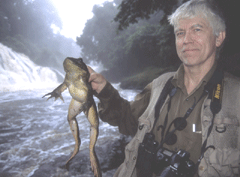
Russ Mittermeier in Equatorial Guinea (Courtesy of Conservation International)
GELLERMAN: It’s Living on Earth. I’m Bruce Gellerman. Genetically speaking, humans are 99 percent the same as other primates. And, of course, we share not only genes with our closest cousins, but the planet. Now, a new report, “The World’s 25 Most Endangered Primates” finds that non-human primates are in peril and so are their habitats. Russell Mittermeier is president of Conservation International and chaired the panel that prepared the report. Hello, Mr. Mittermeier.
MITTERMEIER: Hi, how’re you doing?
GELLERMAN: I’m fine, but it seems like mankind’s closest living relatives—apes, monkeys, lemurs, other primates—aren’t doing as well.
MITTERMEIER: Well, a good percentage of the primates are in pretty serious trouble. Roughly one in every four species of primates—and there are about 650 different kinds of primates out there—about one in every four are going to be either in the critically endangered or the endangered categories, which means, you know, they’re hanging on by the skin of their teeth and they’re really—some of them are quite close to extinction. And what we’re trying to do with this top "25 Most Endangered Primates" list is highlight some of those species that are really, really in grave danger of disappearing. But one of the ways I like to convey how severely depleted these animals actually are is to say that if you gave every individual of those 25 species a seat in a football stadium, you probably wouldn’t be able to fill an entire large football stadium with all the remaining individuals representing these 25 species, which I think is pretty sobering. We’re looking at less than 100,000 individuals of all of these species combined.

A Sumatran Orangutan (Courtesy of Conservation International)
MITTERMEIER: Well there are a number of different threats to nonhuman primate populations. Firs of all, about 90 percent of them are—90 percent of primates are tropical rainforest animals and of course rainforests have suffered a lot over the past 40 or 50 years. On top of that you have the issue of bush meat huntings as a source of food and in Asia in particular, as a medicinal products, a source of medicinal products.
GELLERMAN: We have some sound from an orangutan—the Sumatran Orangutan? Have I pronounced that correctly?
MITTERMEIER: Mmm hmm. Yes, orangutan. Mmm hmm. Man of the forest.
GELLERMAN: Man of the forest?
MITTERMEIER: ‘Oran’ is man in Indonesian and ‘gutan’ is forest.
GELLERMAN: Well, here’s some sound from the man of the forest.
[SOUNDS OF MAN OF THE FOREST]
GELLERMAN: What’s going on there?
MITTERMEIER: I’m not entirely sure. But it sounds like there’s a young one that’s perhaps a little distressed. I can’t quite make the sound out but they should be distressed because the Sumatran orangs are down to just a few thousand individuals. They’ve suffered a great deal from oil palm plantations, for example, and heavy logging in Sumatra. Sumatra’s lost a large portion of its habitat over the past 20 or 30 years and they’re just hanging on in a handful of protected areas there. But this is a wonderful creature. It’s not only a great ape. It’s also the largest tree dwelling animal on earth. Great creatures make great potential targets for ecotourism, which could generate a lot of revenue for local communities and yet, they’ve really suffered quite a bit in the past few decades.

Russ Mittermeier in Equatorial Guinea (Courtesy of Conservation International)
MITTERMEIER: The rarest primate that I have ever seen—well I just went looking for the Hainon gibbon, which is down to 19 individuals and I missed it. I didn’t get to see it on this trip. I’m going to have to go back and try again. I guess that on that list—the rarest species on that list that I have seen would have to be the greater bamboo lemur from Madagascar. This is a fascinating animal. It’s a bamboo specialist, rather like a little primate version of a giant panda. It can crack open—it only weighs about 2 kilos, about five pounds – yet it can crack open stems of giant bamboo, really hard stems. And it can digest cyanide. It’s quite an amazing creature. And right now there are probably less than 100 of those that we know of, and I think the latest estimate—we’re probably up around 60-70 documented individuals remaining of this species. And it’s not just a unique species. It’s also a unique genus of primates that’s found only in a few remaining forest patches that’s found in the few remaining rainforests of Madagascar. Another interesting thing about primates is that we’re still discovering new species all over the place, which is remarkable. Here we are in the 21st century, you would think that all of the species of our closest living relatives would have already have been catalogued and described by scientists, but that’s not the case and in fact, in places like Madagascar, and parts of the Amazon, we’re finding new species every year.
GELLERMAN: So some primates are actually doing well then?
MITTERMEIER: Well I wouldn’t say necessarily that the new ones being discovered are doing well, it’s just that we’ve overlooked them up until now. I mean, that’s one of the most exciting aspects of our work. That, while we’re trying very hard to conserve those that are threatened with extinction, we’re also making some wonderful new discoveries of species that were previously unknown. And some of those that we discover are already in such a depleted condition, there are such tiny ranges under threat that as we describe them we have to put them in the endangered category.
GELLERMAN: Russell Mittermeier is the president of Conservation International. To learn more about “The World’s 25 Most Endangered Primates” list, go to our website: loe.org. Mr. Mittermeier, thank you very much.
MITTERMEIER: Thank you. It’s my pleasure.
Related links:
- To see the report from Conservation International and the World Conservation Union click here.
- To see video of the Sumatran Orangutan click here
- Conservation International
Is Chicken Little Right?
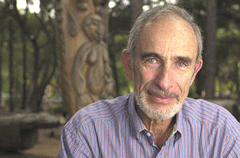
Paul Ehrlich (Photo: Linda A. Cicero/Stanford New Service)
GELLERMAN: Well, non-human primates aren’t the only ones in peril. So are we, and so is the planet. That, according to a recent UN report called “Global Environment Outlook 4.” Achim Steiner is executive director of the panel that produced the study.
STEINER: The sobering and not surprising findings are that on virtually all major variables of development, we still have to conclude that the signs are pointing downwards. We have not turned the corner on major issues such as energy, climate change, loss of biodiversity, decline in fisheries, deforestation.
GELLERMAN: The UN panel warns that even “mass extinction” is possible. Of course, there have been bleak warnings about the fate of the Earth before. Among the most famous of pessimistic predictions is from biologist Paul Ehrlich. In 1968 Ehrlich wrote “The Population Bomb,” a landmark book in which he predicted that as a result of an exploding population, by 1985, quote: ‘the battle to feed all of humanity will be over,’ And that, ‘in the 1970s and 80s hundreds of millions of people will starve to death in spite of any crash programs embarked upon now.’
Paul Ehrlich is now at Stanford University and we’ve called him up to see if he’s changed his perspective. Hi, Professor Ehrlich.
EHRLICH: Nice to be here.
GELLERMAN: You know, this UN report is pretty pessimistic. Uh, and you’ve got a history of being something of a professional pessimist. Is it time for me to start walking down the street with a sign saying ‘The End is Near’?
EHRLICH: Uh, I think it’s time for people to take very seriously the things we’re doing to our life support systems. In other words—it’s not just me that’s pessimistic. In 1993, 58 academies of science said—that is basically all the academies of science in the world—said if we don’t change our ways, we’re doomed. And 1500 of the world’s leading scientists sent out a statement called “World Scientists’ Warning to Humanity,” said exactly the same thing. It wasn’t covered in the press at all. The scientific community has been trying to warn society about the various things we’re facing and it just hasn’t penetrated the media or certainly governments.

Paul Ehrlich (Photo: Linda A. Cicero/ Stanford News Service)
EHRLICH: Forty years ago and perfectly correct. We still have about a billion people who don’t get enough food to function properly. In 1968 in the same book I warned about the possibilities of global warming, and that’s something the scientific community has known about since about 1898. None of this stuff is new. It’s just a massive report happened to come out of the UN saying ‘all the trends are in the wrong direction.’ And they’re perfectly correct but it’s something again, the scientific community has been saying as loud as it could for a long time.
GELLERMAN: So we’re facing an existential crisis?
EHRLICH: We’re facing a crisis in which the way in which many of us live will not be possible for the vast majority of people—sometime in the relatively near future. Hopefully after I’m dead, but maybe not.
GELLERMAN: Well according to the UN report, by 2050 there will be about 9.7 billion people on the planet. Is that in excess of the carrying capacity of the planet?
EHRLICH: Certainly in anything like today’s lifestyle. You know if you try to move to a battery—what my colleague calls a battery-chicken type of world, in which everyone has the absolute minimum to keep them alive—it might be possible.
GELLERMAN: Did you say 'battery chicken?'
EHRLICH: Battery chickens are these situations where you raise billions of chickens in one building, you know where every chicken as a square foot and just is in there and gets fed and uh, grows. That’s the battery-chicken world, where everybody is living the absolutely minimum standard of living so you can maximize the number of people. If we want, for example, the United States to go on for thousands and thousands of years, the way to do it isn’t to see how many people we can cram in in the next 20. You’ve got to remember we’re at about 6.6 billion now, talking about adding about 2.5 billion more.
First of all, 2.5 billion is 500 million people more than were on the planet when I was born in 1932. So we’re adding more than existed when I was born. Second, the next two and a half billion are going to be a lot more expensive to take care of environmentally than the previous 2.5 billion because people are smart, they farm the best lands first. You know you can’t get oil by sticking a pointed stick in the ground in Pennsylvania anymore. You got to drill down a couple of miles. And water has to be transported long distances. And I think anybody who reads the newspapers and can count, can see that we’re in deep trouble just from the numbers of people versus the resources that are available. Ask them in Atlanta, where they’re running out of water. Ask them in Southern California, where climate change is helping huge fires to devastate areas. I was just in Brazil, and the Pantanal swamp area was burning and the Cerrado, the savannah areas south of the Amazon, were burning in record bouts. So, you know, you just have to look around to see what’s happening.
GELLERMAN: Well Professor, I can’t resist the word play temptation. You know, you say battery chicken, some people say Chicken Little.
EHRLICH: Well they say Chicken Little but again, I warned 40 years ago about climate change, what do we have going on now? I warned 40 years ago about emergent diseases, what do we have now? I warned 40 years ago that if we didn’t do something about the population situation, people would still be hungry. Well, we’ve got many, many millions of people hungry. So, Chicken Little says the sky is falling. Well, maybe Chicken Little is right.
GELERMAN: According to the UN report, each person on the planet needs about 22 hectares. But I’m thinking, you know, there’s Hong Kong, there’s New York, you know, uh—
EHRLICH: Well, that’s right but the thing you got to remember is that the people in New York don’t live on New York. They import stuff from acres all over the rest of the world. Where, it’s a common fall—it’s actually been named by the scientific community ‘the Netherlands fallacy,’ the idea that the whole planet can be as crowded as the Netherlands. And of course it’s not people versus area, it’s people versus the resources that support them. And those resources include things called ‘sinks,’ like the capacity of the atmosphere to absorb carbon dioxide. That’s a very important resource for the planet. It’s one we’re overusing at the moment.
GELLERMAN: Are we as a species capable of comprehending and dealing with problems of this magnitude?
EHRLICH: Sure we are. We’re perfectly capable of it. We’re the dominant animal on the planet. We’re in many ways brilliant but we haven’t gotten the political and ethical will together to do the things we ought to be doing. And the educational system is deteriorating. The media don’t generally cover this stuff. I mean if you look at the top stories in the media, how often do they deal with the fact that we’re within decades of losing our civilization. It’s almost never mentioned. There are some things now that’s coming out but for instance you would think, watching the media today, that the only big threat is climate change. But of course many people feel for instance that the number of toxic substances we’re adding to the environment are an even bigger threat. In many villages in the Arctic and sub Arctic, there are only half as many male babies being born as female babies and it’s likely a sign of the hormone-mimicking chemicals that we manufacture, release into the environment, and that are carried by the climate systems to the poles. The threat of emerging diseases—the first one of course, has been AIDS, the first really big one in recent decades—but the more people we have, the greater the threat—particularly to the ones that malnourished—of new plagues taking over, a new flu, and so on. So that’s considered a huge threat. And the loss of biodiversity, the other organisms that are a working part of our life support systems, is also a huge threat. I mean, even economists are looking at issues like: are we consuming too much now? In other words, the scholarly community is enormously concerned and the general public and particularly our so-called leadership is utterly ignorant so it’s not a great situation.
GELLERMAN: So it has not reached the tipping point?
EHRLICH: We don’t know. But what other choice do we have but to try and change so that if we haven’t reached the tipping point, we don’t reach it, because the tipping point is going to be miserable and an awful lot of people will die and lifestyles will change very, very dramatically, and so we don’t want to do that so you know, I can’t be incredibly optimistic about what we’re going to do. What we can say is that societies can change very rapidly when the time is ripe. Look for instance how rapidly the Soviet Union disappeared when none of us expected it to. When I was a kid, lynchings were common in the south of the United States. They aren’t any more. In other words, things can change very rapidly. We don’t fully understand why but when the time is ripe, they change and I think that your chore and mine is to try to ripen the time.
GELLERMAN: Well Professor, it’s been a real pleasure talking with you. Thank you very much.
EHRLICH: It’s a pleasure to me too, thank you very much.
GELLERMAN: Paul Ehrlich is Bing Professor of Population Studies at Stanford University.
Related link:
To see UNEP's fourth Global Environment Outlook report, click here
[MUSIC: Alan Pasqua “Prayer” from ‘the Anti-Social Club’ (Cryptogramophone—2007)]
Channeling Thoreau
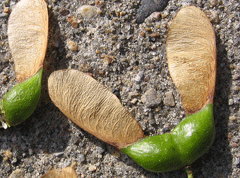
Whirlybirds (Maple Seeds) (Photo: Flickr/Greenhem)
GELLERMAN: Writer Tom Montgomery-Fate recently decided to re-read Henry David Thoreau’s classic journal “Walden.“ But it wasn’t until Montgomery-Fate closed the book and began to wander through a nearby meadow that he was able to fully appreciate the meaning of the words.
MONTGMERY-FATE: On a cool, sunny afternoon, I sit in a small cabin in the woods reading Walden. The long, winding streams of words sparkle with insight. But after riding the raft of Thoreau’s consciousness for several hours I lose track of where it’s going. I know that’s the point—the journey matters, not the destination—but on page 154 I get snagged on this long sentence:
‘In our most trivial walks we are constantly, though unconsciously, steering like pilots by certain well-known beacons and headlands, and not 'til we are completely lost or turned around—for a man needs only to be turned around once with his eyes shut in this world to be lost—do we appreciate the vastness and strangeness of nature.’

Maple Seeds (Photo: Flickr/Greenhem)
I sit down in the dry grass and try to watch the flight of one individual seed. But I can’t do it. I’m lost in the awe of the whirling multitude, and in the whoosh and whistle of the wind, which has blown into a surprising gale. It is here, amid the timeless language of wind and seed, I understand Thoreau's words––that by steering through the ‘vastness and strangeness’ of nature with an open eye and ear, I can wake up and trust the quiet faith of a maple tree and a thousand whirling prayers.
GELLERMAN: Tom Montgomery-Fate teaches writing at the College of DuPage in Glen Ellyn, Illinois. His most recent book is a memoir “Steady and Trembling.”
Related link:
Tom Montgomery-Fate, Professor of English, College of DuPage, Illinois
[MUSIC: Jake Shimabukuro “Blue Roses Falling” from ‘Gently Weeps’ (Hitchhike Records—2006)]
GELLERMAN: Just ahead, turning plowshares into swords over food. Stay tuned to Living on Earth.
ANNOUNCER: Support for the environmental health desk at Living on Earth comes from the Cedar Tree Foundation. Support also comes from the Richard and Rhoda Goldman Fund for coverage of population and the environment. This is Living on Earth on PRI: Public Radio International.
Diet for a Dying Planet
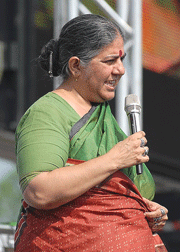
(Photo: Flickr/U2005.com)
GELLERMAN: It’s Living on Earth. I’m Bruce Gellerman. In India, the benefits of modern agriculture come with a high price. It’s been reported as many as 150,000 Indian farmers over the past decade have committed suicide—many by drinking the pesticides they put on their crops. According to physicist and social activist Vandana Shiva, the farmers’ despair is due to the weight of overwhelming debt. They can no longer afford the escalating price of chemicals and bio-engineered seeds, like pest-resistant Bt cotton. Shiva says the suicides in India are only part of a global problem that can be traced to the way food is produced.
SHIVA: Chemical agriculture really is a theft from nature. Organic ecological farming is the only way we will be able to address the ecological crisis related to farming, the agrarian crisis emerging from industrial globalized agriculture, and the public health crisis coming from using war chemicals to produce our food.
GELLERMAN: Vandana Shiva is editor of a new book called "Manifestos on the Future of Food and Seed." Living on Earth's Steve Curwood recently spoke with her about the problems, the politics, and the possibilities of food production.
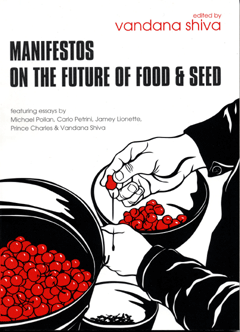
Mainfestos on the Future of Food and Seed (Courtesy of South End Press)
SHIVA: The connections between the environment and agriculture, and food systems, and the issues of poverty really came home to me in the 80s, particularly 1984—and I don’t why George Orwell picked that as the title of one of his books. It was the year we had the worst terrorism and extremism in India. Thirty thousand people were killed in Punjab where the Green Revolution had been implemented—the Green Revolution had even received a Nobel Peace Prize for creating prosperity and through prosperity creating peace. And yet in the 1980s, there was the worst form of violence you could imagine. In December of 1984, we had the worst industrial disaster in Bhopal, which killed 3,000 people in one night, 30,000 people since then, and I was forced to wake up and ask the question: why are we involved in an agriculture that is killing hundreds of thousands, that is so violent, and pretends to be feeding the world? And I started to do scientific research on this. My book “The Violence of the Green Revolution” came out of the research that I was doing at that point for the United Nations. And increasingly, I have realized that if farmers in India are getting into debt and committing suicide, it’s because of these industrially driven agricultural systems that are also destroying the environment. If children are going hungry today and are being denied food, it’s because the money is being spent on buying toxic chemicals and costly seeds rather than being spent on feeding children, clothing them, and sending them to school. So chemical agriculture really is a theft from nature and a theft from the poor.
CURWOOD: In your book Vandana Shiva, you mention that 800 million people in the world who suffer from malnutrition, and the 1.7 billion who suffer from obesity. What is it that the underfed and the overfed have in common?
SHIVA: Both are suffering from consequences of corporate control over the food system, which has reduced food to commodities, manipulated it, got the farmers into debt. The farmers and farmers’ children who are hungry today are the ones who have to sell what they produce in order to pay back credit for buying the chemicals they use to grow the food. The majority of the hungry in the world are rural people today. They could be growing their own food if the food system hadn’t been converted into a market for sales of seeds and agrichemicals. And on the other hand, the obesity epidemic and other related epidemics of diabetes—and in Delhi, childhood diabetes, children with diabetes, has jumped from seven percent to 14 percent in the city of Dehli, as the staple diet of Coca-Cola and chips starts to enter our school system—both are victims. Three billion people on this planet are being denied their right to healthy, safe, nutritious food even though the planet can produce that food, and farmers of the world can produce that food, because agribusiness has turned that food into a place for highest returns on profits.
CURWOOD: Now, anyone who goes grocery shopping here in the U.S. can tell you that organically-produced foods are more generally more expensive than conventional foods and yet, in your book you write that conventional food is not the key to feeding the poor. Tell me about what you call the ‘myth’ of cheap food?
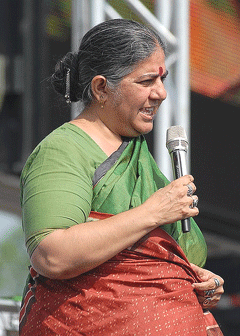
Vandana Shiva speaking at the "Deine Stimme Gegen Armut" (Your Voice Against Poverty) concert in Rostock, Germany on June 7th, 2007.(Photo: Flickr/U2005.com)
CURWOOD: Now, some of the companies will tell you that genetically modified foods help increase food production, making more food available. You’ve been opposed to genetically modified foods since they first came on the market. What do you see wrong with genetically modified crops?
SHIVA: Well, you know the first thing is if they were so productive, Indian farmers, who are using Bt cotton, wouldn’t be the worst victims of farmer suicides. One scientist keeps churning out data about how $27 million additional income—if the farmers were making that additional income, they wouldn’t be ending their lives. The recent Nobel Prize in biology has gone to biologists who have shown that the determinism on which genetic engineering is based doesn’t work. Genes work in very complex interactions. This is why those of us who critique genetic engineering started to critique it as a very crude and primitive technology, based on very wrong assumptions of how life organizes itself. This idea of one gene, one expression doesn’t work. Because of the crudeness of the technology, industry has so far managed to bring us, commercially, only two kinds of traits. One is herbicide-tolerant crops, which means spray more ground up, contaminate your ecosystems and food systems more. And the second is Bt toxin crops, where a toxin called Bt is engineered into the plant and now every cell is making that toxin every moment. It starts to kill nontarget species, the very big study of Cornell on the monarch butterflies is one example, 1,800 sheep in India dying by eating Bt cotton is another example, (inaudible) studies that shows that genetically engineered food fed to mice starts to create huge damage physiologically, immunity systems collapse, the brains shrunk. We need much more research of this kind. Unfortunately the industry censures the research, pretends that everything is fine and starts to target the scientists, who have brought some level of awareness to society of the risks of manipulating life at the genetic level or assessing the consequences adequately.
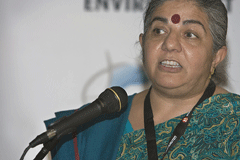
Vandana Shiva (Photo: Flicr/Daniel Heaf)
SHIVA: Agrichemicals that have come into farming were war chemicals. They’re products of war. When 30,000 people died in Bhopal, it’s because those pesticides were designed to kill people. Herbicides were designed as chemical warfare. 243D was Agent Orange of the Vietnam War. So the tools of agriculture have become the tools of warfare. Secondly, the idea of creating food dependency is also an idea of warfare. It came out of the foreign policy of the United States the very word and phrase ‘use food as a weapon.’ It’s being used against India today in friendship. The interesting thing is that the U.S. and India are very intimate today, but the U.S.-India agreement on agriculture is trying to create dependency of India on the United States. Supplies of food, even though we’re growing 74 million tons. This is warfare by another means.
CURWOOD: You want to build a new paradigm for food. What does that mean exactly?
SHIVA: I think the first element of the paradigm is that food is not a commodity. It’s the very basis of life. Secondly, food production is not industrial activity. It is nurturing the land. It is conserving resources. It is giving livelihoods. It is shaping a culture. And it is much more than bringing corn and soya bean and wheat and cotton to the marketplace. We have to recognize that biodiversity is the real capital of food and farming and linked to it is cultural diversity—that we are richer to the extent we have diversified food cultures in the world. We are poorer as the biodiversity of our farms disappears and the cultural diversity of our food systems disappears.
CURWOOD: So what should the average person do in terms of a response to your call?
SHIVA: I think the average person should recognize that even though they are in cities they are connected to the land. That somewhere, somebody produced the food they’re eating. And we will all be freer, if around every city are rural communities where small farmers are able to produce food of quality, make a living doing that, and there is a more intimate connection between the food people eat and the land it comes from and the producers who have made an effort to bring it. I think every city should have its own food shed. The creation of farmers' markets is a beginning. But I don’t think we can leave the farmers' markers to be token symbols. We need to move the money of taxpayers from subsidizing corporations to bring us junk and poison, to bringing farmers' markets everywhere, to helping small producers everywhere connect to those who are looking for more secure food, more safe food, more tasty food, more quality food. The most important issue is to break the myth that safe, ecological, local, is a luxury only the rich can afford. This planet cannot afford the additional burden of more carbon dioxide, more nitrogen oxide, more toxins in our food. Our farmers cannot afford the economic burden of these useless toxic chemicals. And our bodies cannot afford the bombardment of these chemicals anymore.
CURWOOD: Dr. Vandana Shiva is a physicist and environmental activist. Thank you so much.
SHIVA: Thank you, Steve.
GELLERMAN: Vandana Shiva is also the editor of a new book called, “Manifestos on the Future of Food and Seed." She spoke with Living on Earth Executive Producer Steve Curwood.
Related link:
Additional information on "Manifestos on the Future of Food and Seed"
[MUSIC: Anouska Shankar “Sinister Grains” from ‘Rise’ (Angel Records 2005)]
High Infatuation
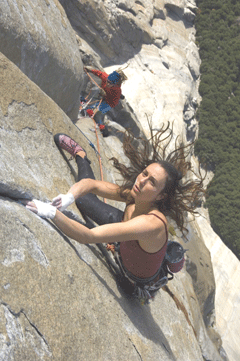
Steph Davis rock climbing. (Courtesy of Steph Davis)
GELLERMAN: Steph Davis knows her way up a rock face. Climbing tooth and nail to the top of some of the world’s highest peaks is what she does for a living. Steph Davis is the first woman to climb 11,000-foot Fitz Roy Peak in Patagonia, and she’s done first ascents in Pakistan, Baffin Island in Canada, and Kyrgyzstan. Throughout her life, Davis has made sacrifices to pursue her passion for climbing. And she’s written about it in her book “High Infatuation - A Climber’s Guide to Love and Gravity.” We have this audio profile of professional climber Steph Davis.
[MUSIC: Dan Ross “Klimbim” from ‘Passion Session’ (Narada Records 1999)]
DAVIS: The first day I went climbing, everyone was like ‘oh, let’s take the cute girl climbing!’ And then boom! I go do this thing and I’m like ‘oh my God. This is my thing. I have to do this.’ And then, I just had to change everything.
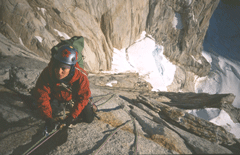
Steph Davis alpine climbing. (Courtesy of Steph Davis)
There are a lot of different kinds of climbing. And, of course I love rock climbing. It’s simple and pure and beautiful. But Alpine climbing has also really drawn me as well because—mostly because I just like to be there. I like to be in those places. That’s how you get into the mountains. And then things get way more intense as well, in an Alpine climbing situation. There’s a lot of endurance associated—like maybe 24-hour, 36-hour pushes, where you’re just going the whole time. It’s so elemental, you know. You’re sleeping on the wall or in the snow cave and your whole life is a very different thing. It’s much more simple and everything means a lot more.

Steph Davis rock climbing. (Courtesy of Steph Davis)
Related link:
Steph Davis' website
GELLERMAN: Steph Davis’ book is called “High Infatuation; A Climber’s Guide to Love and Gravity.” Our audio profile was produced by Living on Earth’s Ashley Ahearn. And on the next Living on Earth, teaching diplomats to nurture nature for world peace.
ALI: A peace park is a place where the environment is being instrumentally used to resolve conflicts. In fact, conflicts which may have nothing to do with the environment could be resolved through environmental peace building.
GELLERMAN: War, peace, and the environment, next week on Living on Earth.
[SOUND OF BELLS, CHIMES]
GELLERMAN: We leave you this week on the streets of New Delhi. This audio montage of residential streets and the marketplace is on the CD “Into India—A Composer’s Journey,” recorded by Hildegard Westerkamp.
[MUSIC: Hildegard Westerkamp “Gently Penetrating” from ‘Into India: A Composer’s Journey’ (Earsay Productions 2002)]
GELLERMAN: Living on Earth is produced by the World Media Foundation. Our crew includes Ashley Ahearn, Bobby Bascomb, Eileen Bolinsky, Ingrid Lobet, Helen Palmer, Emily Taylor, and Jeff Young. Our interns are Alexandra Gutierrez and Mitra Taj.
And this week, we say “so long” to Kelley Cronin. Although Kelley worked behind the scenes, her calm and steady manner played a big role in getting us on the air every week. Thanks Kelley, you were an asset to LOE and we wish you well in your new endeavors.
Jeff Turton is our technical director. Alison Lirish Dean composed our themes. Steve Curwood is our executive producer. You can find us at loe.org. I’m Bruce Gellerman. Thanks for listening.
ANNOUNCER: Funding for Living on Earth comes from the National Science Foundation, supporting coverage of emerging science. And Stonyfield Farm: organic yogurt and smoothies. Stonyfield pays its farmers not to use artificial growth hormones on their cows. Details at Stonyfield.com. Support also comes from you our listeners, the Ford Foundation, the Town Creek Foundation, the Oak Foundation, supporting coverage of climate change and marine issues, and Pax World Mutual Funds, socially and environmentally sustainable investing. Pax World: for tomorrow. On the Web at PaxWorld.com.
ANNOUNCER 2: PRI: Public Radio International.
Living on Earth wants to hear from you!
Living on Earth
62 Calef Highway, Suite 212
Lee, NH 03861
Telephone: 617-287-4121
E-mail: comments@loe.org
Newsletter [Click here]
Donate to Living on Earth!
Living on Earth is an independent media program and relies entirely on contributions from listeners and institutions supporting public service. Please donate now to preserve an independent environmental voice.
NewsletterLiving on Earth offers a weekly delivery of the show's rundown to your mailbox. Sign up for our newsletter today!
 Sailors For The Sea: Be the change you want to sea.
Sailors For The Sea: Be the change you want to sea.
 The Grantham Foundation for the Protection of the Environment: Committed to protecting and improving the health of the global environment.
The Grantham Foundation for the Protection of the Environment: Committed to protecting and improving the health of the global environment.
 Contribute to Living on Earth and receive, as our gift to you, an archival print of one of Mark Seth Lender's extraordinary wildlife photographs. Follow the link to see Mark's current collection of photographs.
Contribute to Living on Earth and receive, as our gift to you, an archival print of one of Mark Seth Lender's extraordinary wildlife photographs. Follow the link to see Mark's current collection of photographs.
 Buy a signed copy of Mark Seth Lender's book Smeagull the Seagull & support Living on Earth
Buy a signed copy of Mark Seth Lender's book Smeagull the Seagull & support Living on Earth

